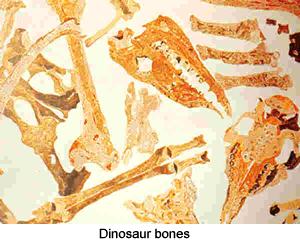BACKGROUND:
The bones of different animals are very unique and can be distinguished
easily. For example, a larger animal has proportionately larger bones than a
small animal. The larger the animal, the greater the bone diameter needed to
support the weight of the animal. Larger bones usually correspond to a lack
of agility; a mouse is much quicker in its movements than is an elephant.
Students sometimes do not realize that bones are living parts of
organisms. For example, the interior of a bone is porous. Some of these
openings host blood vessels.
PROCEDURE:
- Ask the students to bring a chicken bone and a steak bone to school.
Make sure the bones have been cleaned.
- Instruct the students to carefully draw the bones. Make sure they look
at cross-sections, not just the surfaces. They should discover that both
types of bones have something in common - a porous interior. After they
have discovered this, explain that the holes hosted blood vessels that
nourished the bones when they were part of a living organism.
- Ask the students to list differences between the bones. They should
note that the steak bone is more dense than the chicken bone; use this
to lead a discussion about how the two organisms live. Bird bones tend
to be light and hollow, because birds are small, and because they need
lightweight bones to be able to fly.